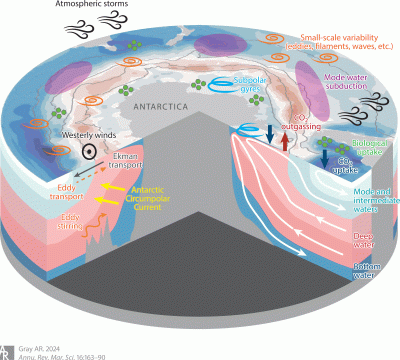The Four-Dimensional Carbon Cycle of the Southern Ocean
This paper provides a review of recent literature, highlighting advances in the understanding of Southern Ocean carbon transport and storage. Many of these advances are provided by new biogeochemical-Argo floats equipped with pH and other biogeochemical sensors.
Assessing the current state of knowledge and remaining gaps emphasizes the need to move beyond the zonal mean picture and embrace a four-dimensional understanding of the carbon cycle in the Southern Ocean.
The Southern Ocean plays a fundamental role in the global carbon cycle, dominating the oceanic uptake of heat and carbon added by anthropogenic activities and modulating atmospheric carbon concentrations in past, present, and future climates. However, the remote and extreme conditions found there make the Southern Ocean perpetually one of the most difficult places on the planet to observe and model, resulting in significant and persistent uncertainties in our knowledge of the oceanic carbon cycle there. The flow of carbon in the Southern Ocean is traditionally understood using a zonal mean framework, in which the meridional overturning circulation drives the latitudinal variability observed in both air-sea flux and interior ocean carbon concentration. However, recent advances, based largely on expanded observation and modeling capabilities in the region, reveal the importance of processes acting at smaller scales, including basin-scale zonal asymmetries in mixed-layer depth, mesoscale eddies, and high-frequency atmospheric variability.

